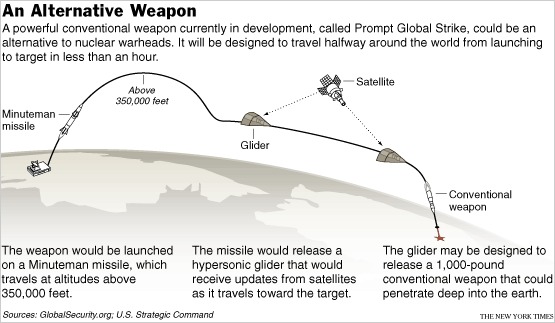Factoring Russia into the US–Chinese equation on hypersonic glide vehicles
by noreply@blogger.com (brian wang) from NextBigFuture.com on (#2FWTH)
Hypersonic glide vehicles are a growing factor in strategic stability calculations. These systems are characterized by speed, precision and manoeuvrability, which can be applied to defeat missile defences. Traditional calculations of strategic stability rely on the ability to undermine an opponent's nuclear deterrent capability, and hypersonic glide vehicles are seen as providing this assurance.
On reaching near space, the systems are ejected from their missile boosters to begin their glide phase, during which they can accelerate to upwards of Mach 5 or 6138 kilometers per hour. The glide phase allows them to manoeuvre aerodynamically to evade interception and extends the range of their booster missiles. Unlike conventional re-entry vehicles, which follow a predictable ballistic trajectory, hypersonic glide vehicles are almost impossible to intercept using conventional missile defence tracking systems. Given these technical attributes, it is little wonder that a number of countries (including nuclear and non-nuclear powers), such as China, Germany, India, Israel, Japan, Pakistan, Russia and the United States, are thought to be developing hypersonic or glide-oriented capabilities or both.
* Dr Wu Riqiang at Renmin University believes South Korea's deployment of THAAD could well lead to China increasing its nuclear warhead numbers
There are at least four possible options for addressing hypersonic glide weapons in terms of negotiations:
* traditional arms control;
* an arms race;
* trilateral talks; and
* multilateral exchanges.

A SIPRI (SIPRI is an independent international institute dedicated to research into conflict, armaments, arms control and disarmament. Stockholm International Peace Research Institute) Insights Paper seeks to take the current dyadic approach to US-Chinese competition in the field and to insert Russia as a factor in shaping China's views on the subject. Presenting the key takeaways from 872 of 1675 surveyed Chinese-language texts, the author reviews more than a decade of research on hypersonic and boost-glide technologies, revealing a growing Chinese interest in Russia. Combining this trend with both countries' shared concerns over US missile defences suggests that it is time to start factoring in how Russia's calculations on its own prompt global strike programme might shape China's decisions on future nuclear and conventional payloads, and the targets and range of its own hypersonic glide vehicle programme.
Russia and China are not simply linked by China's increased interest in Russia's hypersonic glide developments. China's renaming of its Second Artillery Corps as the People's Liberation Army Rocket Force (PLARF) and the publication of its 2015 Military Strategy White Paper also hint at a growing convergence.
The full implications of this name change and restructuring, which seemingly mirror Russia's own Strategic Rocket Force, are as yet unclear. Yet, there is an emerging similarity between the two forces. The PLARF commands all three legs of China's nuclear triad and is now thought to be on an equal footing with the ground, naval and air forces of the People's Liberation Army (PLA). While China's 2015 Military White Paper may not be as specific as Russia's 2015 Military Doctrine, it emphasizes a similar vision of a global revolution in military affairs tied to long-range, precise, smart, stealthy and unmanned weapons in both outer space and cyberspace.
Read more










On reaching near space, the systems are ejected from their missile boosters to begin their glide phase, during which they can accelerate to upwards of Mach 5 or 6138 kilometers per hour. The glide phase allows them to manoeuvre aerodynamically to evade interception and extends the range of their booster missiles. Unlike conventional re-entry vehicles, which follow a predictable ballistic trajectory, hypersonic glide vehicles are almost impossible to intercept using conventional missile defence tracking systems. Given these technical attributes, it is little wonder that a number of countries (including nuclear and non-nuclear powers), such as China, Germany, India, Israel, Japan, Pakistan, Russia and the United States, are thought to be developing hypersonic or glide-oriented capabilities or both.
* Dr Wu Riqiang at Renmin University believes South Korea's deployment of THAAD could well lead to China increasing its nuclear warhead numbers
There are at least four possible options for addressing hypersonic glide weapons in terms of negotiations:
* traditional arms control;
* an arms race;
* trilateral talks; and
* multilateral exchanges.

A SIPRI (SIPRI is an independent international institute dedicated to research into conflict, armaments, arms control and disarmament. Stockholm International Peace Research Institute) Insights Paper seeks to take the current dyadic approach to US-Chinese competition in the field and to insert Russia as a factor in shaping China's views on the subject. Presenting the key takeaways from 872 of 1675 surveyed Chinese-language texts, the author reviews more than a decade of research on hypersonic and boost-glide technologies, revealing a growing Chinese interest in Russia. Combining this trend with both countries' shared concerns over US missile defences suggests that it is time to start factoring in how Russia's calculations on its own prompt global strike programme might shape China's decisions on future nuclear and conventional payloads, and the targets and range of its own hypersonic glide vehicle programme.
Russia and China are not simply linked by China's increased interest in Russia's hypersonic glide developments. China's renaming of its Second Artillery Corps as the People's Liberation Army Rocket Force (PLARF) and the publication of its 2015 Military Strategy White Paper also hint at a growing convergence.
The full implications of this name change and restructuring, which seemingly mirror Russia's own Strategic Rocket Force, are as yet unclear. Yet, there is an emerging similarity between the two forces. The PLARF commands all three legs of China's nuclear triad and is now thought to be on an equal footing with the ground, naval and air forces of the People's Liberation Army (PLA). While China's 2015 Military White Paper may not be as specific as Russia's 2015 Military Doctrine, it emphasizes a similar vision of a global revolution in military affairs tied to long-range, precise, smart, stealthy and unmanned weapons in both outer space and cyberspace.
Read more